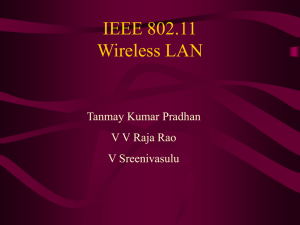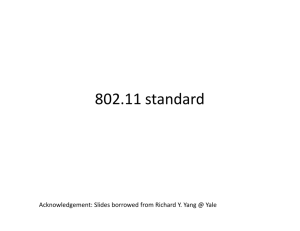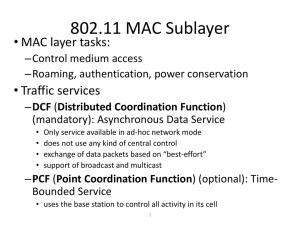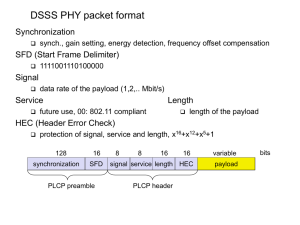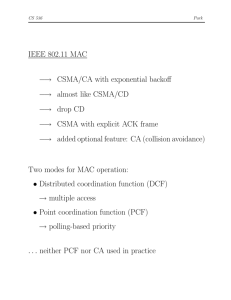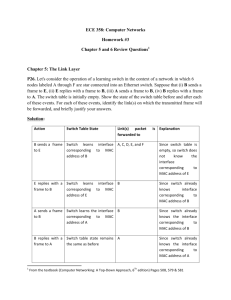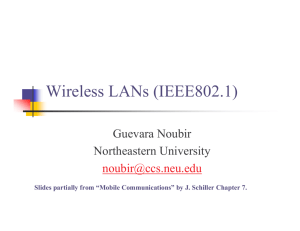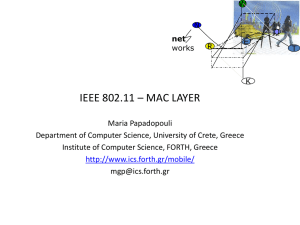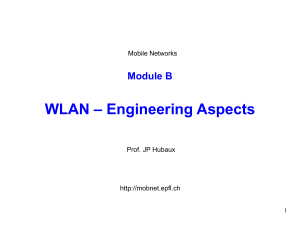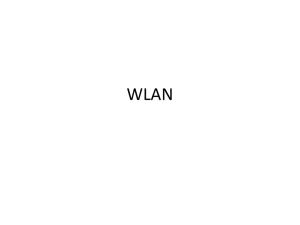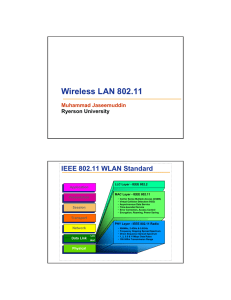ppt
advertisement
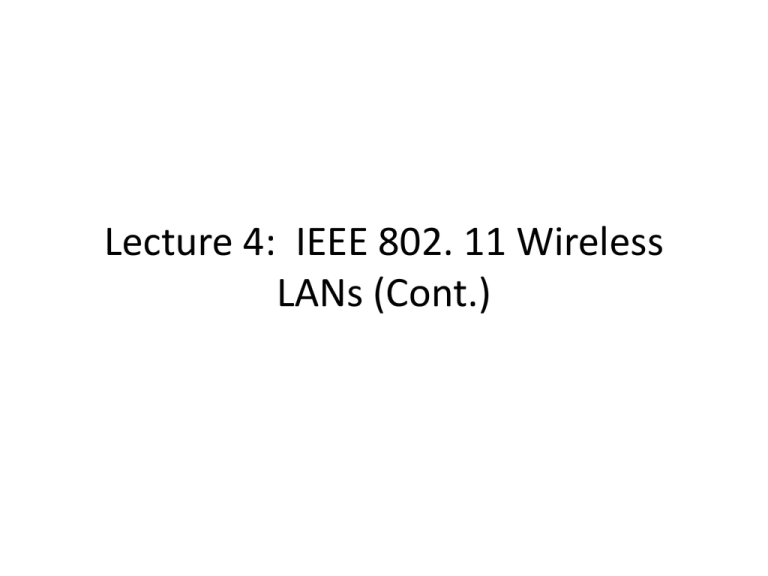
Lecture 4: IEEE 802. 11 Wireless LANs (Cont.) Mobile Communication Technology according to IEEE (examples) Local wireless networks WLAN 802.11 WiFi 802.11a 802.11h 802.11i/e/…/n/…/z/aa 802.11b 802.11g ZigBee Personal wireless nw WPAN 802.15 802.15.4 802.15.4a/b/c/d/e/f/g 802.15.5, .6 (WBAN) 802.15.2 802.15.1 802.15.3 Bluetooth Wireless distribution networks WMAN 802.16 (Broadband Wireless Access) WiMAX + Mobility [802.20 (Mobile Broadband Wireless Access)] 802.16e (addition to .16 for mobile devices) 802.15.3b/c 802.11 - Layers and functions • MAC • PLCP Physical Layer Convergence Protocol – access mechanisms, fragmentation, encryption • MAC Management – clear channel assessment signal (carrier sense) • PMD Physical Medium Dependent – synchronization, roaming, MIB, power management – modulation, coding • PHY Management – channel selection, MIB LLC MAC MAC Management PLCP PHY Management PMD Station Management PHY DLC • Station Management – coordination of all management functions 802.11 - MAC layer I - DFWMAC • Traffic services – Asynchronous Data Service (mandatory) • exchange of data packets based on “best-effort” • support of broadcast and multicast – Time-Bounded Service (optional) • implemented using PCF (Point Coordination Function) • Access methods – DFWMAC-DCF CSMA/CA (mandatory) • collision avoidance via randomized “back-off“ mechanism • minimum distance between consecutive packets • ACK packet for acknowledgements (not for broadcasts) – DFWMAC-DCF w/ RTS/CTS (optional) • Distributed Foundation Wireless MAC • avoids hidden terminal problem – DFWMAC- PCF (optional) • access point polls terminals according to a list • Priorities 802.11 - MAC layer II – defined through different inter frame spaces – no guaranteed, hard priorities – SIFS (Short Inter Frame Spacing) • highest priority, for ACK, CTS, polling response – PIFS (PCF IFS) • medium priority, for time-bounded service using PCF – DIFS (DCF, Distributed Coordination Function IFS) • lowest priority, for asynchronous data service DIFS DIFS medium busy PIFS SIFS direct access if medium is free DIFS contention next frame t 802.11 – Inter Frame Spacing 802.11b 802.11a 802.11g aSIFSTime 10 usec 16 usec 10 usec aSlotTime 20 usec 9 usec 20 usec (mixed); 9 usec (g only) aDIFTime (2xSlot+SIFS) 50 usec 34 usec 50 usec; 28 usec 6 802.11 - CSMA/CA access method I • station ready to send starts sensing the medium (Carrier Sense based on CCA, Clear Channel Assessment) • if the medium is free for the duration of an Inter-Frame Space (IFS), the station can start sending (IFS depends on service type) • if the medium is busy, the station has to wait for a free IFS, then the station must additionally wait a random back-off time (collision avoidance, multiple of slot-time) • if another station occupies the medium during the back-off time of the station, the back-off timer stops (fairness) DIFS DIFS medium busy direct access if medium is free DIFS contention window (randomized back-off mechanism) next frame t slot time (20µs) 802.11 - competing stations - simple version DIFS DIFS station1 station2 DIFS boe bor boe busy DIFS boe bor boe busy boe busy boe bor boe boe busy station3 station4 boe bor station5 busy bor t busy medium not idle (frame, ack etc.) boe elapsed backoff time packet arrival at MAC bor residual backoff time 802.11 - CSMA/CA access method II • Sending unicast packets – station has to wait for DIFS before sending data – receivers acknowledge at once (after waiting for SIFS) if the packet was received correctly (CRC) – automatic retransmission of data packets in case of transmission errors DIFS sender data SIFS receiver ACK DIFS other stations waiting time data t contention 802.11 - DFWMAC • Sending unicast packets – station can send RTS with reservation parameter after waiting for DIFS (reservation determines amount of time the data packet needs the medium) – acknowledgement via CTS after SIFS by receiver (if ready to receive) – sender can now send data at once, acknowledgement via ACK – other stations store medium reservations distributed via RTS and CTS DIFS sender RTS data SIFS receiver other stations CTS SIFS SIFS NAV (RTS) NAV (CTS) defer access ACK DIFS data t contention Fragmentation DIFS sender RTS frag1 SIFS receiver CTS SIFS frag2 SIFS ACK1 SIFS SIFS ACK2 NAV (RTS) NAV (CTS) other stations NAV (frag1) NAV (ACK1) DIFS contention data t DFWMAC-PCF I (almost never used) t0 t1 medium busy PIFS point coordinator wireless stations stations‘ NAV SuperFrame SIFS D1 SIFS SIFS D2 SIFS U1 U2 NAV DFWMAC-PCF II t2 point coordinator wireless stations stations‘ NAV D3 PIFS SIFS D4 t3 t4 CFend SIFS U4 NAV contention free period contention period t 802.11 - Frame format • Types – control frames, management frames, data frames • Sequence numbers – important against duplicated frames due to lost ACKs • Addresses – receiver, transmitter (physical), BSS identifier, sender (logical) • Miscellaneous – sending time, checksum, frame control, data bytes 2 2 6 6 6 2 6 Frame Duration/ Address Address Address Sequence Address Control ID 1 2 3 Control 4 bits 2 2 4 1 1 1 1 1 1 1 0-2312 4 Data CRC 1 Protocol To From More Power More Type Subtype Retry WEP Order version DS DS Frag Mgmt Data MAC address format scenario ad-hoc network infrastructure network, from AP infrastructure network, to AP infrastructure network, within DS to DS from DS 0 0 0 1 address 1 address 2 address 3 address 4 DA DA SA BSSID BSSID SA - 1 0 BSSID SA DA - 1 1 RA TA DA SA DS: Distribution System AP: Access Point DA: Destination Address SA: Source Address BSSID: Basic Service Set Identifier RA: Receiver Address TA: Transmitter Address Special Frames: ACK, RTS, CTS bytes • Acknowledgement ACK 2 2 6 Frame Receiver Duration Control Address bytes • Request To Send • Clear To Send RTS CRC 2 2 6 6 Frame Receiver Transmitter Duration Control Address Address bytes CTS 4 2 2 6 Frame Receiver Duration Control Address 4 CRC 4 CRC Example: 802.11b Throughout • Suppose TCP with 1460 bytes payload – 802.11b data frame size (not including preamble): 1536 bytes – TCP ACK data frame size (not including preamble): 76 bytes • 802.11b ACK frame size 14 bytes • Suppose 802.11b at the highest rate – 8 bits per symbol – 1.375 Msps Q: What is TCP/802.11b throughput? http://www.andrews.edu/~swensen/Wifi%20Throughput.pdf Example: 802.11b Throughout • Each transaction requires 2,084 μs. At that duration, 479 exchanges can complete per second. With a TCP payload of 1,460 bytes per exchange, the throughput is 5.7 Mbps. Backup Example: 802.11b Throughout 802.11b Data Rate Specifications Data Rate Code Length Modulation Symbol Rate Bits/Symbol 1 Mbps 11 (Barker Sequence) BPSK 1 MSps 1 2 Mbps 11 (Barker Sequence) QPSK 1 MSps 2 5.5 Mbps 8 (CCK) QPSK 1.375 MSps 4 11 Mbps 8 (CCK) QPSK 1.375 MSps 8
